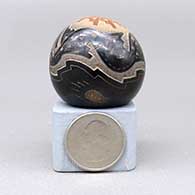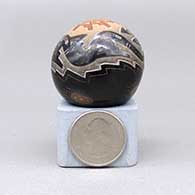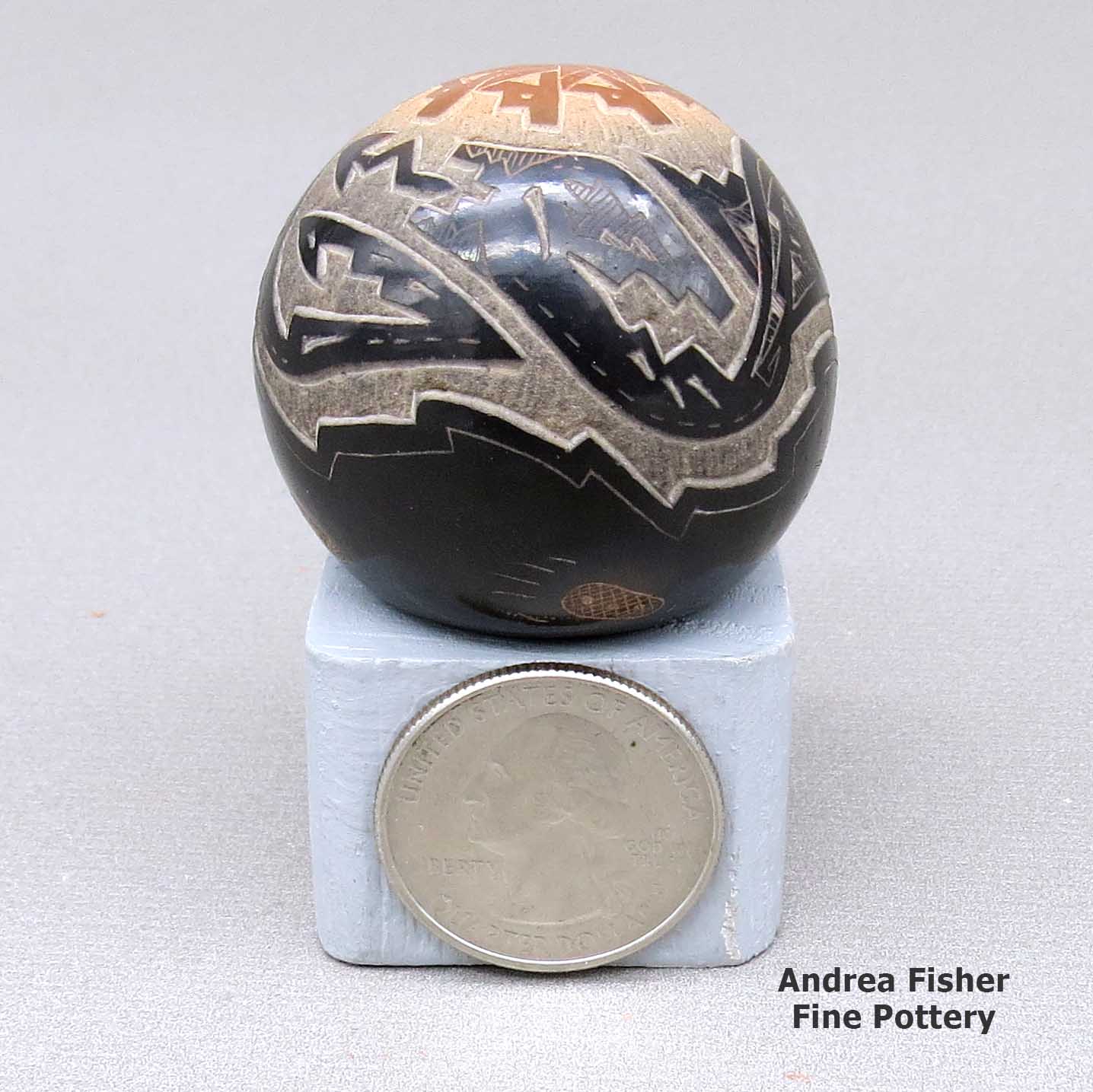
Santa Clara
$ 125
josc3k126
Miniature black seed pot with sienna spots and a sgraffito avanyu, bear paw, kiva step, and geometric design
1.5 in L by 1.5 in W by 1.5 in H
Condition: Very good
Signature: Sammy Naranjo Melony Gut Santa Clara Pueblo
Tell me more! Buy this piece!
(505) 986-1234 - www.andreafisherpottery.com - All Rights Reserved
Sammy Naranjo
Santa Clara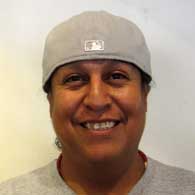
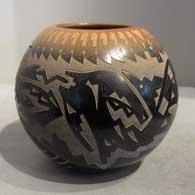
Sammy Naranjo, (Okuwa Nae' Khung Tsire meaning Dark Cloud Bird), was born in 1972 into the Pueblo of Santa Clara. He is a member of the Tree Clan and is related to Barbara Martinez (birth mother), Flora Naranjo (adoptive mother), Glenda Naranjo (aunt), Vickie Martinez (sister) and Chris and Manuel Martinez (brothers).
Sammy tells us he was about twelve when his mother, Flora Naranjo, inspired him to create traditional carved pottery. Today, Sammy specializes in and is well known for his black and sienna jars decorated with finely executed sgraffito designs such as the Avanyu (water serpent), feather patterns and bear claws.
Sammy gets his clay from a sacred place on Santa Clara Pueblo. He processes the clay himself, ridding it of impurities and preparing it for use. Then he builds a pot by hand coiling and shaping it, then by polishing it with stones. He fires his black pots the traditional way, outdoors with wood and horse manure. In his words: "I enjoy making pottery because I like to come up with my own traditional designs. I also find that etching my pots is a challenging and rewarding experience. My pottery is unique in the way that no other pot is the same. It is like the pottery is alive. It wants to be a certain way and no matter what I do it won't change the outcome of what the pot wants to look like."
Sammy has earned awards at the New Mexico State Fair, Eight Northern Indian Arts & Crafts Show and the Arizona State Museum. He signs his work "Sammy Naranjo, Santa Clara Pueblo."
Melony Gutierrez
Santa Clara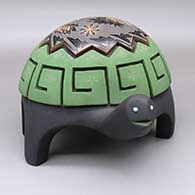
Melony Gutierrez is a potter from Santa Clara Pueblo. She is also a basket weaver and an educator. She says she learned how to make pottery after becoming Sammy Naranjo's partner.
Legoria Tafoya was Melony's great-grandmother but through the generations, her family line trended into weaving baskets and away from making pottery.
Melony has specialized in making turtle figures with carved, sgraffito and painted designs, sometimes with sienna spots and often with inlaid stones.
Some Awards Won by Melony
- 2023 Santa Fe Indian Market, Classification IIC, Category 701 - Carved or incised, black or red, under eight inches, Honorable Mention
Santa Clara Pueblo

Ruins at Puye Cliffs, Santa Clara Pueblo
Santa Clara Pueblo straddles the Rio Grande about 25 miles north of Santa Fe. Of all the pueblos, Santa Clara has the largest number of potters.
The ancestral roots of the Santa Clara people have been traced to the pueblos in the Mesa Verde region in southwestern Colorado. When that area began to get dry between about 1100 and 1300, some of the people migrated to the Chama River Valley and constructed Poshuouinge (about 3 miles south of what is now Abiquiu on the edge of the mesa above the Chama River). Eventually reaching two and three stories high with up to 700 rooms on the ground floor, Poshuouinge was inhabited from about 1375 to about 1475. Drought then again forced the people to move, some of them going to the area of Puye (on the eastern slopes of the Pajarito Plateau of the Jemez Mountains) and others to Ohkay Owingeh (San Juan Pueblo, along the Rio Grande). Beginning around 1580, drought forced the residents of the Puye area to relocate closer to the Rio Grande and they founded what we now know as Santa Clara Pueblo on the west bank of the river, between San Juan and San Ildefonso Pueblos.
In 1598 Spanish colonists from nearby Yunque (the seat of Spanish government near San Juan Pueblo) brought the first missionaries to Santa Clara. That led to the first mission church being built around 1622. However, the Santa Clarans chafed under the weight of Spanish rule like the other pueblos did and were in the forefront of the Pueblo Revolt of 1680. One pueblo resident, a mixed black and Tewa man named Domingo Naranjo, was one of the rebellion's ringleaders. When Don Diego de Vargas came back to the area in 1694, he found most of the Santa Clarans on top of nearby Black Mesa (with the people of San Ildefonso). An extended siege didn't subdue them so eventually, the two sides negotiated a treaty and the people returned to their pueblo. However, successive invasions and occupations by northern Europeans took their toll on the tribe over the next 250 years. The Spanish flu pandemic in 1918 almost wiped them out.
Today, Santa Clara Pueblo is home to as many as 2,600 people and they comprise probably the largest per capita number of artists of any North American tribe (estimates of the number of potters run as high as 1-in-4 residents).
Today's pottery from Santa Clara is typically either black or red. It is usually highly polished and designs might be deeply carved or etched ("sgraffito") into the pot's surface. The water serpent, ("avanyu"), is a traditional design motif of Santa Clara pottery. Another motif comes from the legend that a bear helped the people find water during a drought. The bear paw has appeared on their pottery ever since.
One of the reasons for the distinction this pueblo has received is because of the evolving artistry the potters have brought to the craft. Not only did this pueblo produce excellent black and redware, several notable innovations helped move pottery from the realm of utilitarian vessels into the domain of art. Different styles of polychrome redware emerged in the 1920's-1930's. In the early 1960's experiments with stone inlay, incising and double firing began. Modern potters have also extended the tradition with unusual shapes, slips and designs, illustrating what one Santa Clara potter said: "At Santa Clara, being non-traditional is the tradition." (This refers strictly to artistic expression; the method of creating pottery remains traditional).
Santa Clara Pueblo is home to a number of famous pottery families: Tafoya, Baca, Gutierrez, Naranjo, Suazo, Chavarria, Garcia, Vigil, Tapia - to name a few.



Santa Clara Pueblo at Wikipedia
Pueblos of the Rio Grande, Daniel Gibson, ISBN-13:978-1-887896-26-9, Rio Nuevo Publishers, 2001
Upper photo courtesy of Einar Kvaran, Creative Commons Attribution-Share Alike 3.0 Unported License
Seed Pots
Acoma, Hopi, Isleta, Jemez, Laguna, San Felipe, San Ildefonso, San Juan, Santa Clara
Acoma Pueblo
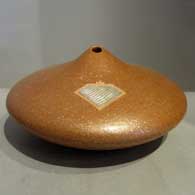
Hopi
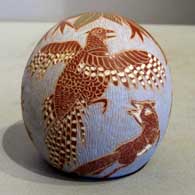
Santa Clara Pueblo
It was a matter of survival to the ancient Native American people that seeds be stored properly until the next planting season. Small, hollow pots were made to ensure that the precious seeds would be kept safe from moisture, light and rodents. After seeds were put into the pot, the small hole in the pot was plugged. The following spring the plug was removed and the seeds were shaken from the pot directly onto the planting area.
Today, seed pots are no longer necessary due to readily available seeds from commercial suppliers. However, seed pots continue to be made as beautiful, decorative works of art. The sizes and shapes of seed pots have evolved and vary greatly, depending on the vision of Clay Mother as seen through the artist. The decorations vary, too, from simple white seed pots with raised relief to multi-colored painted, raised relief and sgraffito designs, sometimes with inlaid gemstones and silver lids.
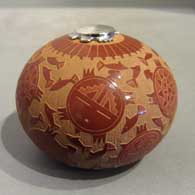
Santa Clara Pueblo
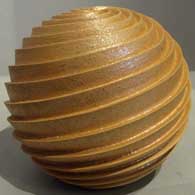
Jemez Pueblo
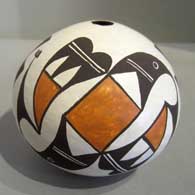
Acoma Pueblo
Miniatures
Most people think that miniature pottery is something new in the world of Native American pottery. In reality, archaeologists have found miniature pottery in the remains of ancient ruins in Chaco Canyon, Mesa Verde, across eastern Arizona, southern New Mexico and south to the Paquimé and Casas Grandes region in northern Mexico. Archaeologists working in the eastern US have found miniature pottery spread across Early Woodland Culture sites, too, dated up to 1700 years ago.
We have no idea as to why the ancients created miniature pottery but there's lots of speculation. Perhaps it was made as toys for children. Perhaps it was made by children learning to make pottery, and as their expertise grew, the size of their pieces grew, too. Perhaps it was made and placed in a firing pit as a good luck charm, hoping that other pots being fired in the pit would survive the firing process and not crack or break. Perhaps it was made for some ceremonial purpose we have no possibility of knowing. We do know that in North America, almost every pottery-making group of ancients made miniature pottery. They decorated it, too, just like the full size pottery the women of the time were making.
As the rebirth of traditionally made Native American pottery has unfolded over the last century, research into the ancient forms, styles and designs has also brought the miniature back into focus. There are more than a few potters these days making tiny gems again, similar to and, at the same time, more refined than the products of the potters of prehistory. And while some are still being made by children learning as they grow up, many more are being made by established adult potters. Some have made their entire careers around the making of miniatures while others sometimes make a few miniatures to complement the full range of forms and styles of full size pieces they make.
Flora Naranjo Family Tree
Disclaimer: This "family tree" is a best effort on our part to determine who the potters are in this family and arrange them in a generational order. The general information available is questionable so we have tried to show each of these diagrams to living members of each family to get their input and approval, too. This diagram is subject to change should we get better info.
- Flora T. & Ramon Naranjo
- Barbara Martinez
- Chris Martinez
- Vickie Martinez
- Sammy Naranjo & Melony Gutierrez
- Justin Naranjo
- Glenda Naranjo & Bruce Gibson
- April Naranjo
- Frances Naranjo Salazar & Jose H.R. Salazar
- Sophie Cata & Frank Cata (San Juan)
- Tricia Velarde
- Morgan Cata
- Pamela Cata
- Stacy Cata
- Angela Salazar
- Daniel Tafoya
- Keshia Tafoya
- Elaine Salazar
- Destiny Atkinson
- Monica Atkinson
- Jose Salazar
- Ronald Velarde
- Yolanda Velarde & James Moquino Sr.
- Keith Chavez
- Camille Moquino (1979-)
- Mario Thomas
- James Moquino Jr.
- Georgette Vigil
- Sophie Cata & Frank Cata (San Juan)
Some of the above info is drawn from Pueblo Indian Pottery, 750 Artist Biographies, by Gregory Schaaf, © 2000, Center for Indigenous Arts & Studies
Other info is derived from personal contacts with family members and through interminable searches of the Internet and cross-examination of the data found.
Copyright © 1998-2024 by


